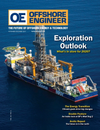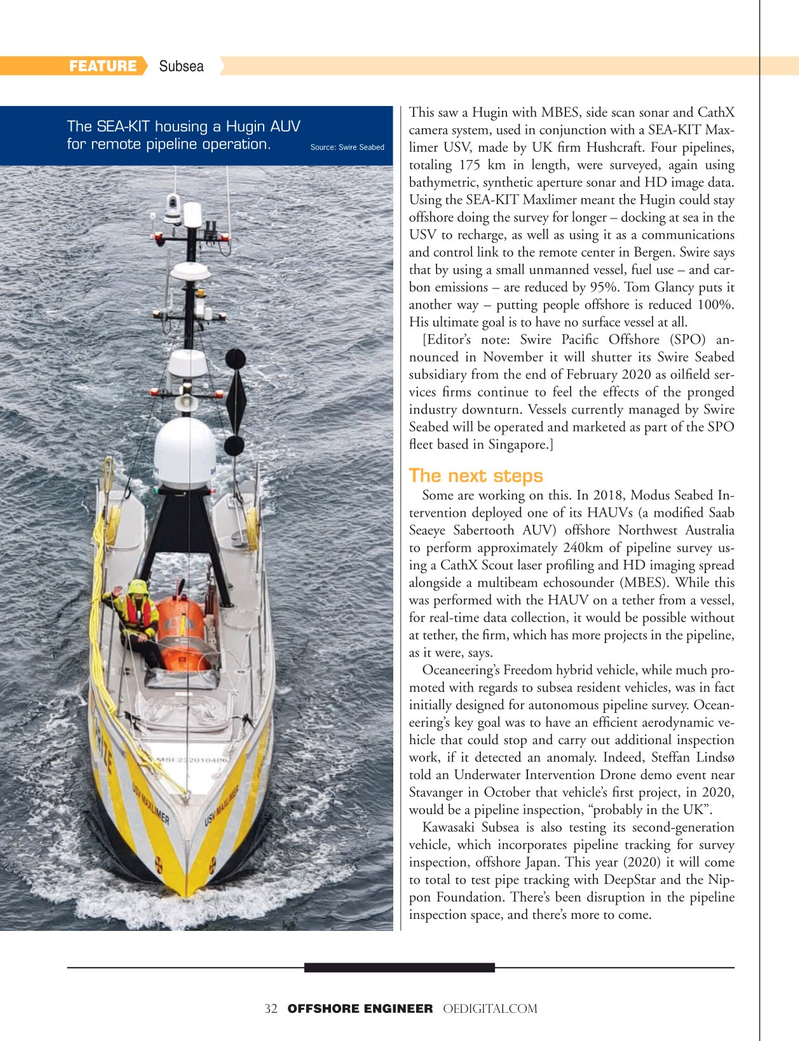
Page 32: of Offshore Engineer Magazine (Nov/Dec 2019)
Exploration Outlook
Read this page in Pdf, Flash or Html5 edition of Nov/Dec 2019 Offshore Engineer Magazine
FEATURE Subsea
This saw a Hugin with MBES, side scan sonar and CathX
The SEA-KIT housing a Hugin AUV camera system, used in conjunction with a SEA-KIT Max- for remote pipeline operation.
Source: Swire Seabed limer USV, made by UK ? rm Hushcraft. Four pipelines, totaling 175 km in length, were surveyed, again using bathymetric, synthetic aperture sonar and HD image data.
Using the SEA-KIT Maxlimer meant the Hugin could stay offshore doing the survey for longer – docking at sea in the
USV to recharge, as well as using it as a communications and control link to the remote center in Bergen. Swire says that by using a small unmanned vessel, fuel use – and car- bon emissions – are reduced by 95%. Tom Glancy puts it another way – putting people offshore is reduced 100%.
His ultimate goal is to have no surface vessel at all.
[Editor’s note: Swire Paci? c Offshore (SPO) an- nounced in November it will shutter its Swire Seabed subsidiary from the end of February 2020 as oil? eld ser- vices ? rms continue to feel the effects of the pronged industry downturn. Vessels currently managed by Swire
Seabed will be operated and marketed as part of the SPO ? eet based in Singapore.]
The next steps
Some are working on this. In 2018, Modus Seabed In- tervention deployed one of its HAUVs (a modi? ed Saab
Seaeye Sabertooth AUV) offshore Northwest Australia to perform approximately 240km of pipeline survey us- ing a CathX Scout laser pro? ling and HD imaging spread alongside a multibeam echosounder (MBES). While this was performed with the HAUV on a tether from a vessel, for real-time data collection, it would be possible without at tether, the ? rm, which has more projects in the pipeline, as it were, says.
Oceaneering’s Freedom hybrid vehicle, while much pro- moted with regards to subsea resident vehicles, was in fact initially designed for autonomous pipeline survey. Ocean- eering’s key goal was to have an ef? cient aerodynamic ve- hicle that could stop and carry out additional inspection work, if it detected an anomaly. Indeed, Steffan Lindsø told an Underwater Intervention Drone demo event near
Stavanger in October that vehicle’s ? rst project, in 2020, would be a pipeline inspection, “probably in the UK”.
Kawasaki Subsea is also testing its second-generation vehicle, which incorporates pipeline tracking for survey inspection, offshore Japan. This year (2020) it will come to total to test pipe tracking with DeepStar and the Nip- pon Foundation. There’s been disruption in the pipeline inspection space, and there’s more to come.
32 OFFSHORE ENGINEER OEDIGITAL.COM

 31
31

 33
33